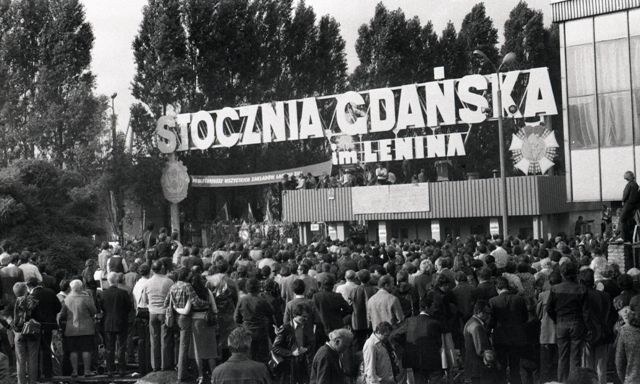By Siobhan Doucette
In June of 1989 semi-free elections were held in Poland; the results surprised onlookers around the world in that they were an unequivocal victory for the Solidarity-led opposition to the ruling communist government. In Books Are Weapons: The Polish Opposition Press and the Overthrow of Communism (Pittsburgh University Press, 2017), I argue that this victory had been made possible in large part due to a nationwide network of activists who expressed themselves through the independent press, which between 1976 and 1989 mirrored and, at times, provided the sinews connecting the Polish democratic opposition.
Creating the independent press
The Poles were not unique within the communist bloc in producing illegal literature; Russian and Czechoslovak samizdat networks were well developed before the Polish independent press took off in 1976. The Poles were, however, unique in the publishing mechanisms they employed. From 1976, the Polish opposition progressively used printing machines rather than retyping publications, as was the norm within samizdat networks.
There were disputes in opposition circles over the transition to printing machines. Within the Workers’ Defence Committee (KOR), Jacek Kuroń initially opposed the idea while Antoni Macierewicz supported it. Kuroń, then the most recognised activist in the democratic opposition, represented KOR’s dominant left-leaning wing, while Macierewicz led its smaller right-sympathetic group. Kuroń feared that the use of printing machines would provide the government with a pretext for breaking up the nascent KOR organisation. He also foresaw difficulties in collecting the necessary equipment and bulk supplies that would be requisite if printing machines were to be used. It was not legal for individuals to possess printing machines, and the sale of printing supplies, including paper, was controlled by the state. Despite these challenges, Macierewicz insisted that printing should be attempted. Ultimately, Poland’s independent press would help in fostering a national opposition network.
The procurement of supplies, production of publications, and their distribution meant that from the late 1970s a network of individuals across Poland actively engaged in regular oppositional activism through the opposition’s “independent press”. Distribution linked these groupings with the population at large, enabling the diffusion of ideas, the expansion of opposition networks, and the widespread financing of opposition. Because publishers charged for their wares, their readership (which grew from thousands in the 1970s to millions in the 1980s) formed a national network of financiers for the active opposition. In addition, the Polish opposition’s independent publishing network connected to sympathetic international organizations, which helped with supply and financing for the independent press and, by extension, the Polish opposition.

Vacat, 1986. Cover depicts protest by Ruch Wolność i Pokój (author’s own image)
Statistics
The statistics related to the Polish independent press reveal its astounding breadth and rapid growth. Between 1976 and August 1980, approximately 80 independent serial titles were produced in Poland. The readership of the independent press was estimated to be 200,000. With the birth of Solidarity, Polish independent publishing expanded exponentially, in part because it became legal (although significant constraints remained in place in reference to what could be published). An estimated 1,896 independent serial titles were produced in 1981!
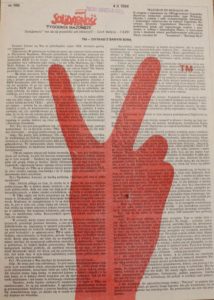
Tygodnik Mazowsze, 1984 (author’s own image)
Martial law, which was declared on 13 December 1981, did not destroy the Polish independent press. Zbigniew Bujak, the unofficial head of underground Solidarity, contended that, “The history of martial law is, to a meaningful degree, the history of underground publishing.” In 1982, an estimated 954 independent serial titles were produced. Although the number of independent serial titles produced between 1980 and 1986 decreased steadily, from 1987 the independent press again began to expand. In 1989, an estimated 1,282 independent serial titles were produced for a regular readership of between 2 and 3 million people.
The vast majority of Polish independent publications between 1976 and 1989 were ephemeral and were produced with print runs in the dozens or hundreds. However, the most significant publications, titles like Tygodnik Mazowsze (many of whose editors would later work on Gazeta Wyborcza), lasted for years, had print runs in the tens of thousands, and maintained distribution networks that crisscrossed Poland.
An independent society in the face of repression
The production of so many publications encouraged the formation of independent publishing houses. These not only produced newspapers, magazines, and journals, but also thousands of book titles, including original works by authors such as Tadeusz Konwicki, Marek Nowakowski, and Tadeusz Mazowiecki. History was a popular topic within the Polish independent press; independent publishers provided uncensored material on Józef Piłsudski, the imposition of communist rule, and the 1968 student protests, among other topics. The press thus provided its readership with access to information, which would not have been otherwise available in Poland.
The expansion of the press sparked a number of remarkable institutions. In addition to publishing houses, some of which remain in existence today, independent publishers created an insurance scheme for independent publishers and a consortium of publishers. The insurance plan provided monies when supplies were taken or people were arrested (and therefore needed to pay fines). The consortium helped in regulating the independent press by encouraging respect for intellectual property rights (which was the norm in the opposition) and aided publishers with the procurement of equipment, supplies, and funds. Independent publishers developed new and impressive publishing techniques (notably in screen printing) while the consortium supported the construction of mimeograph machines; those who used them believed that they had been produced overseas and smuggled into Poland.
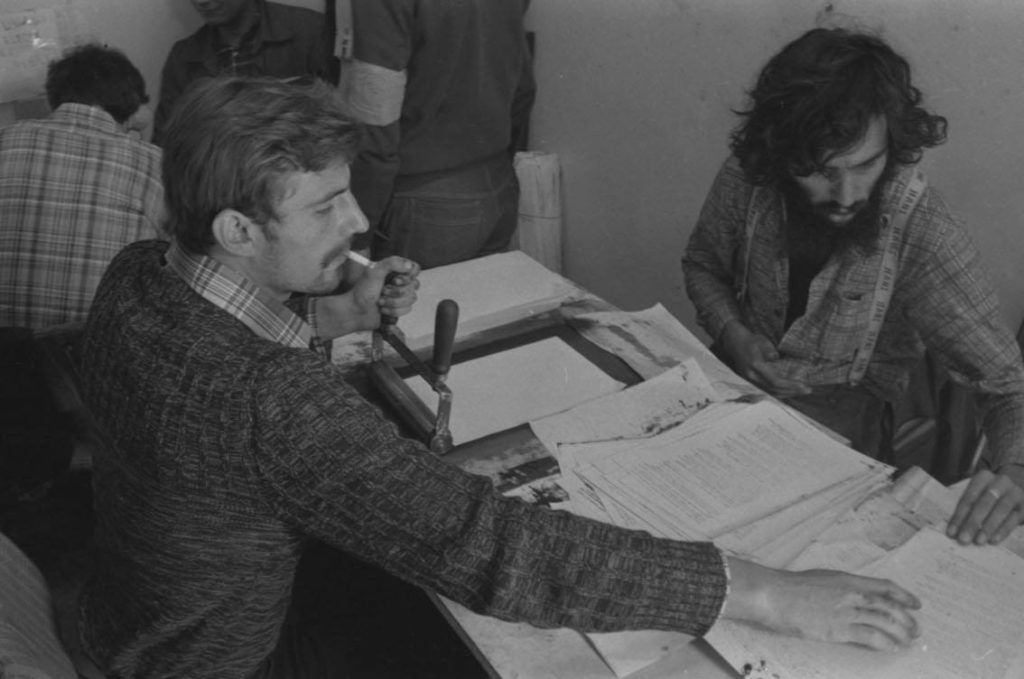
Printers at Lenin Shipyard during August 1980 strikes (Zbigniew Trybek, KARTA)
By the mid-1980s independent publishers had created a remarkable network of foreign supporters who regularly provided independent publishers in Poland with supplies that had been procured abroad. Some supplies were brought in refrigerated trucks with fake walls, while others were smuggled by sea. In one unique instance, publishers let balloons with publications loose from the Baltic, so that they would float into Poland!
Despite the extent of the Polish independent press, the risks involved with it were real. Methods of government repression varied between 1976 and 1989, but people were imprisoned (especially in the early 1980s), fines were imposed, and many associated with the publishing movement were beaten by “unknown assailants”. In addition, publishers dealt with “minor” punishments; these included loss of jobs, expulsion from university, regular house searches, frequent 24- and 48-hour detainments, and denial of passports. And yet the publishing movement endured. For many of its activists, it was not too much to ask of their generation to publish honest works about Poland’s past and present given how many of their forebears had fought and died for an independent Poland. Still, not all publications produced within the independent press focused on what could be construed as political topics.
More than just an oppositional press
The “independent press” was so called because many of its founders and contributors did not seek to establish a press that existed solely to produce works that were written in opposition to the regime; but rather one that provided access to a world of independent thought. Already in the 1970s, poetry from Czesław Miłosz was available from independent publishers as well as literature by foreign authors, including Bohumil Hrabal, George Orwell, and Aleksandr Solzhenitsyn. The first complete published edition of the Gulag Archipelago in the communist bloc was available in Poland, in Polish translation, thanks to Polish independent publishers.
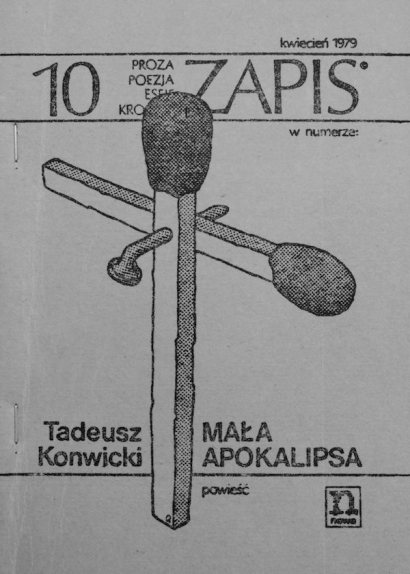
Zapis, 1979 (author’s own image)
By the late 1980s, the Polish independent press was truly pluralistic, with serial publications being produced by and for punks, feminists, environmentalists, and a bevy of other special interest groups. Journals were published that focused on literature, international relations, and human rights among other topics. Independent publications carried song lyrics by Bob Marley and pictures of T. Love, which were meant to be affixed to readers’ walls. Comic books as well as philosophy books were published. Independent cassettes, videos, and films were also produced by those connected to independent publishing.
By exploring the independent press as a whole, it is possible to discern general trends within the opposition. For instance, in 1981 the majority of independent publications (65%) were associated with Solidarity. Solidarity was then the heart of Polish opposition. During the 1980s, the percentage of Solidarity-affiliated titles within the independent press progressively decreased so that in 1989, Solidarity-affiliated titles only accounted for 37% of all independent serial titles. This development reflected the increasingly pluralistic nature of the Polish opposition. Analysis of the independent press shows conclusively that while Solidarity, as an organisation, diminished in strength during the 1980s (until 1987/1988), new elements arose within Polish society, which invigorated the opposition in the early- and mid-1980s.
Martial law broke up the Solidarity monolith; it did not break the opposition. During that 1980s youth serial titles steadily increased in number and as a percentage of the overall independent press. These groups brought attention to issues including the environment and conscientious objection. More important they stepped into the vacuum left when many Solidarity activists retired from active opposition. Analysis of the independent press underlines how profoundly pluralistic the opposition had become by the late 1980s; it is my contention that that was one of its vital strengths.
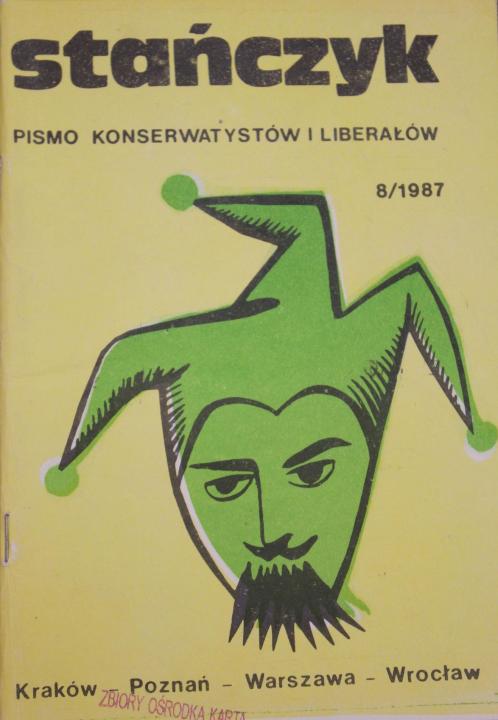
Stańczyk, 1987 (author’s own image)
Fluctuating political trends within the Polish opposition are also apparent through analysis of the press. Social Democratic sympathies within a number of publications in the 1970s mirror the sentiments of many of those at the forefront of the press at its founding (including Adam Michnik and Jacek Kuroń). The inability of right-wing, nationalist tendencies associated with the National Democratic tradition to take hold within the opposition is demonstrated by the paucity of publications openly espousing such views (notable exceptions include Bratniak and Polityka Polska).
Legacy
Editorial boards of independent publications often included individuals who would play a significant role in post-1989 Poland. Examination of the press therefore reveals much about present-day Polish political life. Theoretical disagreements between Głos (the editor-in-chief of which was Antoni Macierewicz, who until January 2018 was Polish minister of national defence and a leading member of PiS) and Krytyka (the editorial board of which included Adam Michnik, current editor-in-chief of Gazeta Wyborcza) are surely relevant for contemporary Poles. Bronisław Komorowski (president of Poland, 2010-2015) was an editor of the journal ABC that focused on Polish international relations; it derived inspiration from Paris Kultura and, like other independent publications that focused on international relations, provides insight into Polish foreign policy post-1989.
Today, there is much discussion in Polish political circles over the legacy of communist rule and who Solidarity’s authentic leaders were. The independent press provides incontrovertible, contemporary information about who the leaders of Solidarity were, but perhaps of greater importance, it reminds us that Solidarity was just one – albeit indispensably important – aspect of a pluralistic opposition. The leaders of Solidarity were not the only leaders of the Polish opposition, just as Solidarity was not the only element in the Polish opposition. Furthermore, what made the Polish opposition – and by extension Solidarity – so impressive was not only its leadership, but its membership and supporters: those hundreds of thousands of individuals who were committed to democratic change and who spent countless hours writing, editing, and hunched over printing machines in support of a free press as well as the millions who read, and paid for, the products of independent publishers’ labours.
The use of printing machines and the high print runs that they made possible ultimately provided Poland with a flexible, dynamic, and ongoing oppositional network rather than a linear chain of regime dissidents, as was the case with samizdat production mechanisms. Similar to contemporary social media networks, which employ Internet blogs, Twitter, Facebook, and so on to geometrically connect like-minded individuals across spatial divides, the press enabled the engendering of an opposition network that extended far beyond immediate peer groups. The basic printing technologies used prevented proliferation on the same scale as social media. However, this apparent technological disadvantage had the very real advantage of helping to make the personal connections necessary in producing and distributing these publications.
The Polish opposition press provides suggestive lessons for those interested in effective civil resistance and regime change. In the wake of the Arab Spring and Euromaidan, there have been numerous debates about the importance of social media as a new and impressive means for organising popular engagement across geographic and social divisions; the Polish independent press provides an example that complicates assumptions about the advantage of modern communication techniques. By producing a physical product, activists in the independent press were forced to make personal contacts that proved of fundamental importance in the face of successive waves of government repression. It was these people, these individuals, who chose to act, often through the press, and in so doing became part of a collective that brought down Soviet-sponsored communist control of Poland.
Main image credit: Citizens of Gdańsk gathered in front of the historic Wlodzimierz Lenin Shipyard Gate 2. by Krzysztof Korczyński. Wikimedia Commons/Marta Malina Moraczewska (under CC BY-SA 3.0 PL)
